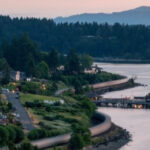
HDR photography, also known as High Dynamic Range photography, is a technique used to capture a wider range of light and color in a single image. This technique involves taking multiple photographs of the same scene at different exposure levels and then merging them together to create a final image that has a higher dynamic range than any of the individual photos.
HDR photography has become increasingly popular in recent years, thanks in part to advancements in digital camera technology and software that make it easier to capture and process HDR images. In this article, we will explore the basics of HDR photography, including how it works, why it is useful, and how to get started with this technique.
How Does HDR Photography Work?
HDR photography works by capturing multiple photographs of the same scene at different exposure levels. Typically, this involves taking three or more photos: one that is properly exposed for the highlights, one that is properly exposed for the midtones, and one that is properly exposed for the shadows.
These individual photos are then merged together using specialized software that combines the best parts of each image to create a final photo that has a wider range of light and color than any of the individual photos.
Why is HDR Photography Useful?
HDR photography is useful because it allows photographers to capture scenes that would otherwise be difficult or impossible to photograph with a single exposure. For example, if you are photographing a landscape with a bright sky and dark foreground, it can be challenging to capture both the sky and foreground properly exposed in a single photo.
With HDR photography, you can capture multiple photos at different exposures and then merge them together to create a final image that has both the bright sky and dark foreground properly exposed.
HDR photography is also useful for creating images with more detail and depth. By capturing a wider range of light and color, HDR images can reveal details in shadows and highlights that might be lost in a single exposure.
How to Get Started with HDR Photography
Getting started with HDR photography is relatively easy. All you need is a digital camera that has the ability to capture multiple exposures and software that can merge the photos together.
To capture multiple exposures, you can use your camera’s bracketing feature, which allows you to take a series of photos at different exposures with a single press of the shutter button. Alternatively, you can manually adjust the exposure settings between shots.
Once you have captured your photos, you will need to use specialized software to merge them together into an HDR image. There are many software options available, including Adobe Photoshop, Photomatix, and Aurora HDR.
Tips for Capturing HDR Photos
Here are some tips to help you capture great HDR photos:
1. Use a tripod: Because you will be taking multiple photos at different exposures, it is important to keep your camera steady to ensure that the images line up properly.
2. Shoot in RAW: Shooting in RAW format will give you more flexibility when processing your HDR images.
3. Bracket your shots: Take multiple photos at different exposures to ensure that you capture all the detail in the scene.
4. Use a remote shutter release: Using a remote shutter release will help minimize camera shake and ensure that your photos are sharp.
5. Experiment with different settings: Try different exposure settings and bracketing options to find the best combination for your scene.
Conclusion
HDR photography is a powerful technique that can help you capture scenes with a wider range of light and color than would be possible with a single exposure. By capturing multiple photos at different exposures and merging them together, you can create stunning images with more detail and depth.
Getting started with HDR photography is relatively easy, and there are many software options available to help you merge your photos together. With some practice and experimentation, you can take your photography to the next level with HDR.







